The Right Tea Newsletter
–
Issue #44 - January 2022
Welcome to the latest issue of The Right Tea Newsletter!
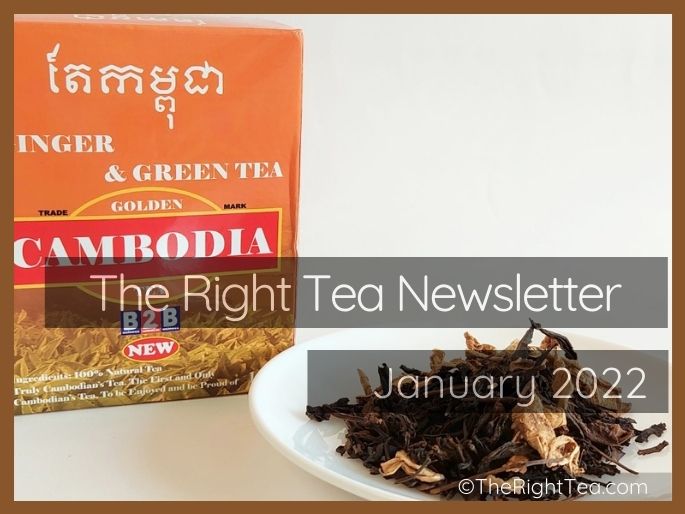
In this issue we will be looking at a tea from Cambodia. This was a present from a family member that had the opportunity to visit the country and could not resist bringing back a box of tea for me to try.
Cambodia produces very little tea, despite the adequate climate and increasing demand for the beverage, there are nearly no tea gardens, so coming across a pack of tea from that country was a real treat.
Teas, such as this one, are a wonderful opportunity not only to try something completely new, but also to explore the history and culture of tea in a particular country.
Let’s begin!
Tea Review: Cambodian Ginger and Green Tea
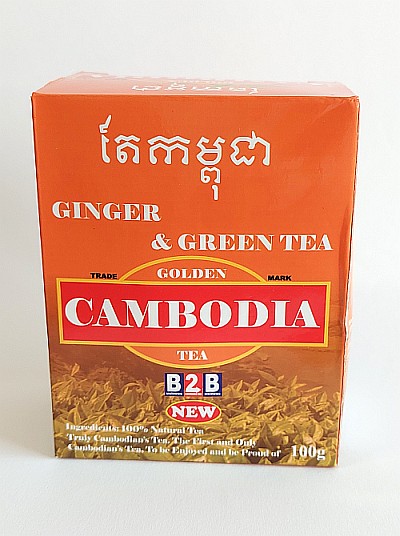
However, ten years later, tea production would be interrupted again due to instability brought on by the Khmer Rouge Regime. Now in the 21st century, due to increasing demand for tea, interest in producing locally in growing again.
Today tea drinking is an important part of the Cambodian culture, most tea being imported. There is even a special tea ceremony as a part of the traditional Cambodian wedding.
In this stage of the ceremony the bride and groom offer tea to the spirit of their ancestors in other to express their gratitude.
In order to promote Cambodian tea production, Chinese tea plants have been imported to start the new tea gardens. Although there is a variety of the tea plant, the camellia sinensis cambodiensis, it is rarely cultivated for tea production on its own. It is mostly used to help create new hybrid cultivars.
Cambodia has long focused on the production of herbs for herbal infusions and traditional herbal remedies, so the transition to creating blended teas is only natural.
Tea Profile
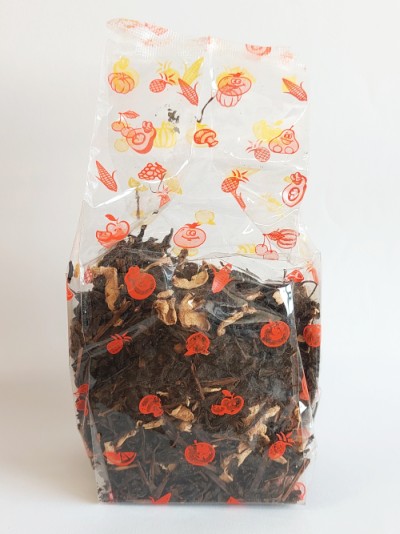
While the cardboard box was sturdy, the plastic packaging tore apart a bit too quickly and easily.
It is clear that the bag will not be the best solution to store the tea and it may need to be transferred elsewhere before it breaks apart even further.
I feel sorry for not storing it in the original box, but I may need to move this into a tea tin that will seal in the tea in properly. Storing your teas properly is important, if you wish them to last you a long time.
Read about tea storage here.
Dry Leaf
Appearance
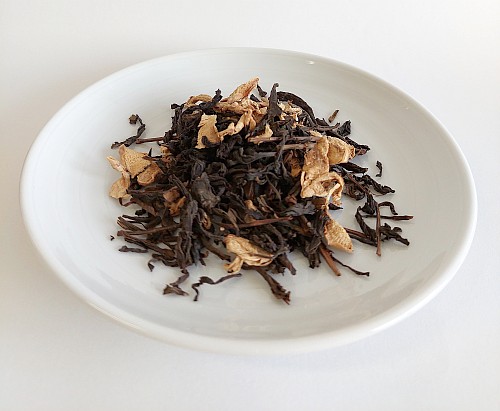
The tea leaves themselves were long, thinly twisted and dark brown in color.
There was no uniformity in size, with some leaves bigger than others, no uniformity in the twist, some leaves more tightly so than others and colored varied a bit, but all in shades of brown.
On further inspection, small isolated twigs were also perfectly visible, signaling that this was not a very careful pluck as the leaves were separated from the stem.
Aroma
As expected with a green tea and ginger blend, the spicy ginger aroma is the most prominent aroma of this tea masking the natural aromas of the green tea leaves.
With such large flakes it was inevitable that this should happen, particularly when you consider that most green tea leaves release very delicate aromas unless they are roasted or smoked.
Brewing Instructions
The suggested brewing instructions are as follows:
- Quantity: 5g of the tea blend per person.
- Pour boiling water and allow to steep for 2 minutes and strain.
- Add sugar to taste.
Using boiling water when brewing green teas may bring out unpleasant flavor, reduce natural sweetness and floral notes and ruin the possibility of rebrewing this tea several times as leaves may be cooked beyond repair.
However, to get the best out of the ginger, you should use boiling water so this is a tough one. Let’s see what happens following these instructions.
Wet/Infused Leaf
Appearance
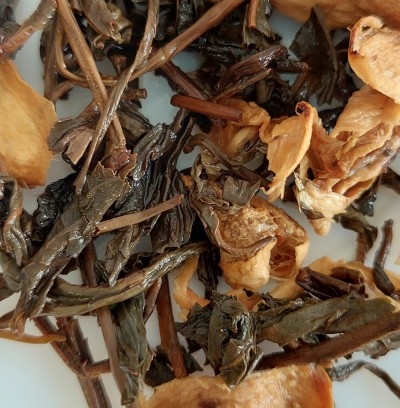
Aroma
The spicy aroma of the ginger really stood out when the leaves were infused, there is a delicate tea aroma lingering behind, but it is clearly masked.
Tea Liquor
Appearance
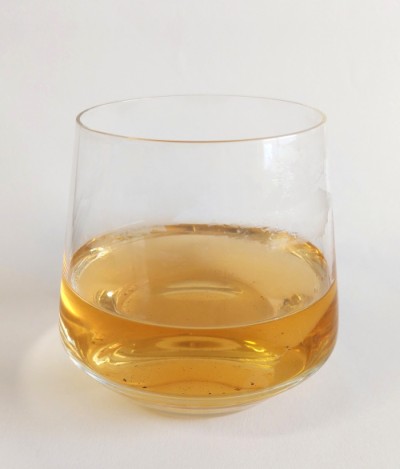
Aroma
Again, it is the ginger that is the star of this tea, overpowering all other aromas. Taking the time to analyze the aromas further, you can detect freshness coming from the green tea.
Generally, ginger tends to be blended with black tea and other herbs to create Christmas tea blends, and in those you can hardly distinguish the aroma of the tea from the rest of the spices.
In this case, there is still a bit of the floral nature of the tea lingering behind the ginger, you just have to take your time and hone your senses.
Taste
The flavor of this tea was amazing. Expecting it to have an overwhelmingly ginger flavor, I was pleasantly surprised that although there was a definite spicy profile, there was a freshness and a delicate floral sweetness in the background.
When hot this tea is not astringent and causes no dryness in the mouth. It is when the tea cools down that you begin to feel some of the typical astringency of green teas and a slight dry sensation. There was no long-lasting aftertaste either with the hot or cold tea.
Final Considerations
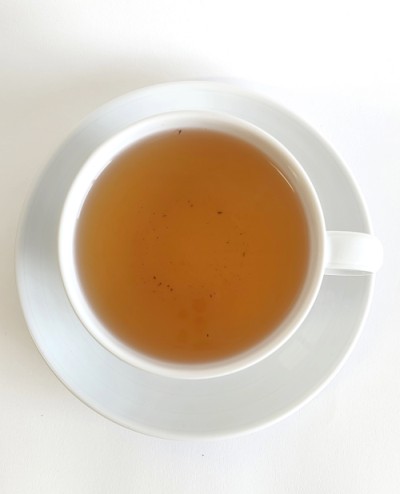
While much of the green tea profile seems to masked by the presence of the ginger in this tea, there is still some freshness that would not have been found if it had been a blend with a black tea.
Upon rebrewing the tea still retained its wonderful layered flavors, but of course, brewing time was increased by 30 seconds.
Third and fourth rebrews seem to lose some of the strength of the ginger as well, which is the price of using boiling water.
There is absolutely no need to add sugar to this tea and doing so only seemed to bury the green tea notes even further in terms of flavor. If you follow the instructions for the brewing time, the tea will have a nicely balanced flavor that requires nothing to be added to it.
Would you taste this Cambodian tea if you had the opportunity to try it?
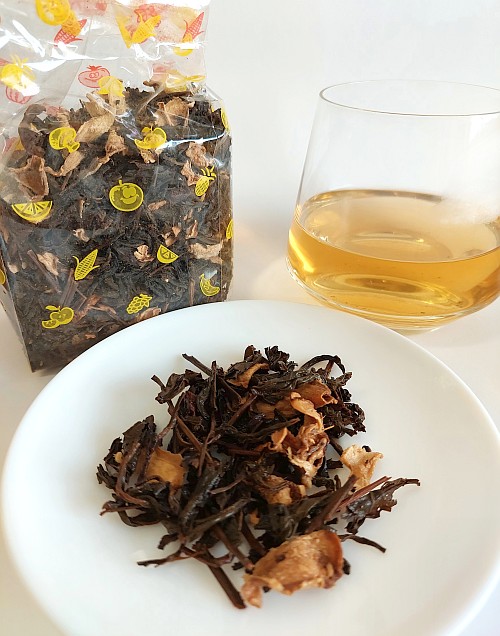
What rare teas are you tasting this year?
What’s Next?
More articles about tea are coming, so keep on the lookout for the next issue of our newsletter. While you wait, look around our website and learn more about tea and its health benefits.
Until then make sure to follow us on Facebook for daily tips and other wonderful tea related items.
Follow us also on Pinterest!
Comments / Suggestions
If you have any comments or suggestions regarding this newsletter or anything you would like to see on the website, make sure to contact us using the form you will find here:
Search Website:
Be healthy
with a wide
choice of herbs!

Prepare your tea!
Try these
Tea Samplers!

Wellness Pack at ArtofTea.com

Award Winning Pack ar ArtofTea.com
Find other
tea time items at ...




